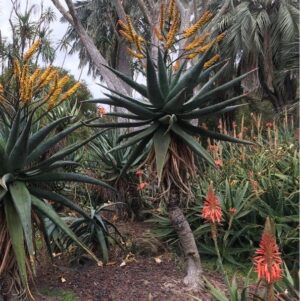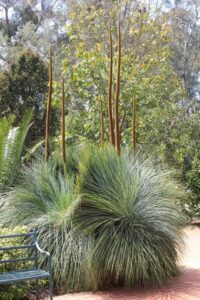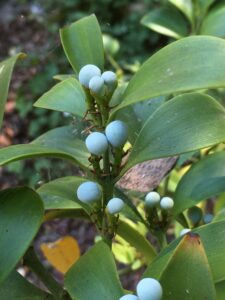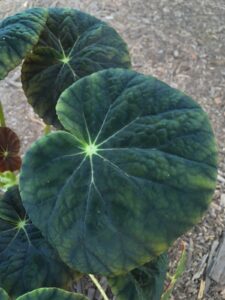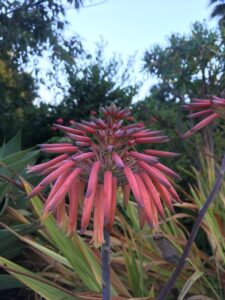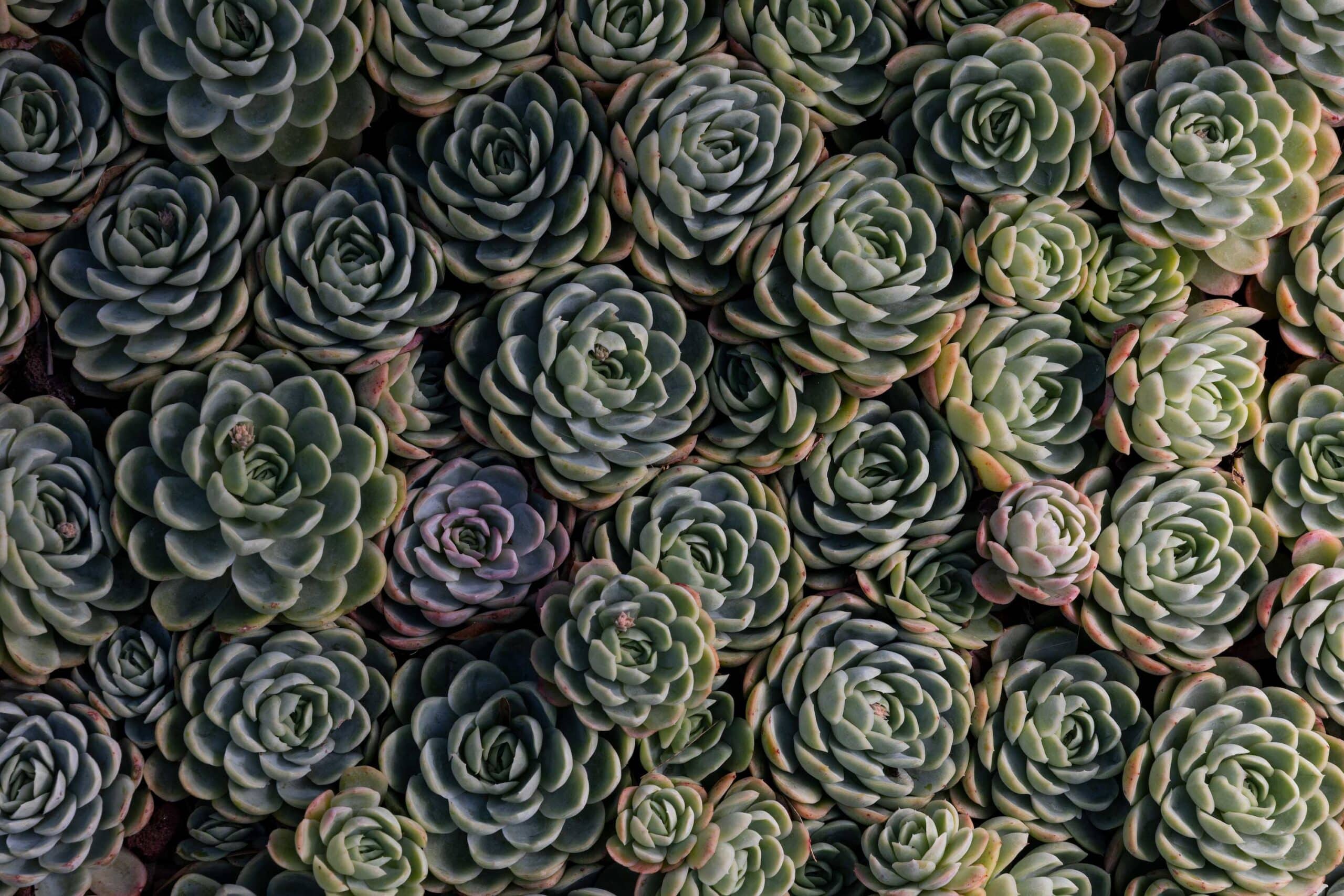
Plant Highlights
Plant Highlights
-
Aloe marlothii
mountain aloe
Highlight Month:
January
Nativity:
Native to mountainous regions of Mozambique, Zimbabwe, Botswana, and eastern South Africa.
Growth Habit:
This tree-like aloe grows to 10’ tall with large spiny leaves. Old leaves persist to cover the trunk in an attractive “skirt.”
Growing Requirements:
Full sun, well-drained soils. Hardy to 20°F.
Features:
Orange flowers are borne in the winter months on a distinctively branched horizontal inflorescence.
Where at Lotusland:
Aloe Garden
-
Xanthorrhoea quadrangulata
Australian grass tree
Highlight Month:
December
Nativity:
South Australia
Growth Habit:
Grass-like foliage covers its thick woody trunk that can reach 6’ tall. Mature plants produce a 6-12’ stalk bearing small white fragrant flowers in the spring. Slow-growing.
Growing Requirements:
Full sun, drought tolerant.
Features:
The scientific name is derived from the Greek ‘xanthos’ (yellow) and ‘rheo’ (to flow), in reference to the resin exuded out of the trunk. The resin is used by Aboriginal Australians for spear-making, patching, and as a varnish. The specific epithet comes from the Latin ‘quadra’ (four) and ‘angulata’ (angular), describing the four-sided cross section of the leaf.
Where at Lotusland:
Australian Garden near the Visitor’s Center
-
Ficus carica ‘Panache’
Striped Tiger Fig
Highlight Month:
October
Nativity:
Garden Origin
Growth Habit:
Ficus carica ‘Panache’ will grow 12-20’ tall but can be pruned for ease of picking.
Growing Requirements:
Full sun, will need supplemental water in extended periods of drought.
Features:
This fig cultivar produces unique variegated fruit with yellow and green stripes! New stems and leaves display a slight variegation as well. Striped tiger figs ripen late in the season compared to other fig selections and our plant at Lotusland is just now producing tasty edible fruit with strawberry-pink, sweet tasting interior flesh. Fig “fruits” are a type of multiple fruit called a syconium, a fleshy, hollow structure lined internally with multiple flowers. Tiny pollinating wasps enter the syconium through an ostiole, the opening on the underside, to pollinate the flowers which later develop into single-seeded fruits (drupelets) that line the interior.
Where at Lotusland:
Deciduous Orchard
-
Agave atrovirens
pulque agave, maguey
Highlight Month:
September
Nativity:
Mexico (Oaxaca, Puebla, and Veracruz)
Growth Habit:
This is the largest of all Agave species and can reach 6-8’ tall with a spread of 8-12’. When mature, the plant will flower and eventually die, but not before producing a 15’ asparagus-like inflorescence with bright yellow flowers.
Growing Requirements:
Sun, well-drained soils. Drought tolerant.
Features:
A. atrovirens it is one of the agaves fermented in the production of pulque and mezcal. The specific epithet, atrovirens, references its dark green leaves (from the Latin ‘ater’= black/dark and ‘virens’= green).
Where at Lotusland:
Dunlap Garden
-
Cleyera japonica
sakaki
Highlight Month:
August
Nativity:
Japan, Korea, China
Growth Habit:
Cleyera japonica, is a broadleaf evergreen shrub. In the wild, this species grows into a small tree, but when cultivated tends to develop a shrubbier habit, reaching 8-10’ tall by 6-10’ wide. New growth emerges a reddish bronze and fades to dark green. Fragrant creamy white flowers appear in mid-summer.
Growing Requirements:
Requires regular irrigation, well drained soils, and light shade.
Features:
It is considered a sacred tree to Japanese mythology and Shinto ritual and is used to construct tamagushi, an offering made of a sakaki branch decorated with strips of washi paper, silk, or cotton.
Where at Lotusland:
Japanese Garden
-
Nageia nagi
nagi, Asian bayberry
Highlight Month:
July
Nativity:
China, Japan, Taiwan
Growth Habit:
Trees will reach 30-50’ high and 15-25’ wide with a pyramidal shape. Evergreen leaves remain leathery and glossy and trunks display attractive bark exfoliating in patches.
Growing Requirements:
Prefers to grow in well-drained loams but is tolerant of poor soils and drought once established.
Features:
This broadleaf conifer is a member of the podocarp family (Podocarpaceae). Members of this species are dioecious, meaning female cones and male catkins are produced on separate plants. This species is uncommon in cultivation.
Where at Lotusland:
Both male and female Nageia nagi can be found in the Japanese Garden at Lotusland.
-
Begonia ‘Yanonali’
Highlight Month:
November
Nativity:
Garden Origin
Growth Habit:
This rhizomatous begonia displays wrinkled blue-green leaves with reddish undersides held on erect stems.
Growing Requirements:
Shade, moist soils
Features:
Rudy Ziesenhenne, world-renowned begonia grower from Santa Barbara, hybridized this cultivar in 1975 and named it after the Chumash chief Yanonali. It is a hybrid of Begonia mazae and B. carrieae. Ziesenhenne operated a nursery from 1934-2005 where Santa Barbara Bowl box office is now located. He was responsible for naming 20 Begonia species and developing 74 hybrids. A native plant and begonia garden now surround the box office in his memory.
Where at Lotusland:
Fern Garden
-
Aloe distans
jewelled aloe
Highlight Month:
July
Nativity:
This aloe is native to the west coast of the Western Cape of South Africa where it grows in shallow soil on limestone rock. It is known from 8-10 locations in a small range from Danger Point to St. Helena Bay.
Growth Habit:
Aloe distans is a sprawling aloe that develops caulescent suckering stems along the ground. It blooms in mid-summer to fall with capitate heads of coral pink tubular flowers. Leaves are borne in tight rosettes with showy yellow triangular teeth.
Growing Requirements:
It prefers full sun to light shade, is drought tolerant, and is hardy to 20-25°F.
Features:
The specific epithet, distans, means “standing apart” or “far removed,” in reference to its geographic separation from similar creeping Aloe species. However, some authorities consider Aloe distans a coastal subspecies of Aloe mitriformis.
Where at Lotusland:
Aloe Garden
-
Coffea arabica
Arabica Coffee
Highlight Month:
Nativity:
E. South Sudan, SW. Ethiopia, N. Kenya
Growth Habit:
Small upright shrubby tree, up to 6-15 feet tall and wide.
Growing Requirements:
Coffee plants prefer protection from cold and drying winds in Santa Barbara but can grow in filtered shade to full sun.
Features:
Our plant came from the UCSB Greenhouses in 1998 and has Costa Rican origins.
Where at Lotusland:
Lotusland is home to one coffee plant tucked into the northern end of the Fern Garden.
-
Agave vilmoriniana
octopus agave
Highlight Month:
Nativity:
NW Mexico
Growth Habit:
An unusual agave with arching, smooth blue leaves resembling a multi-tentacled octopus.
Growing Requirements:
Full sun, well-drained soils
Features:
This plant is native to northwest Mexico where it grows on cliff faces. After flowering, many plantlets are produced on the 15-20’ inflorescence. This agave will reach 4’ tall and wide in its lifetime.


